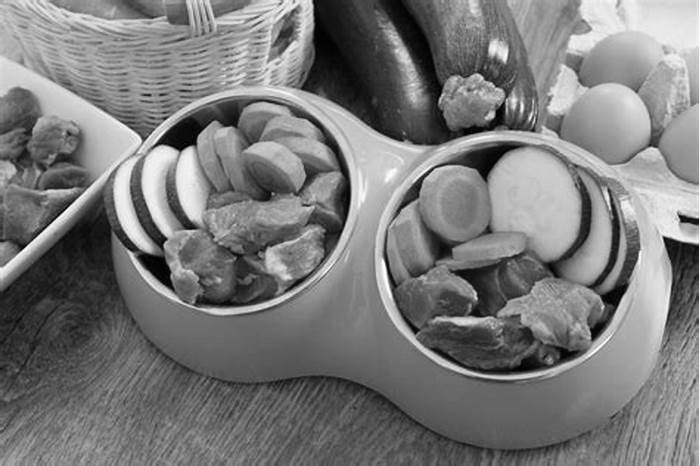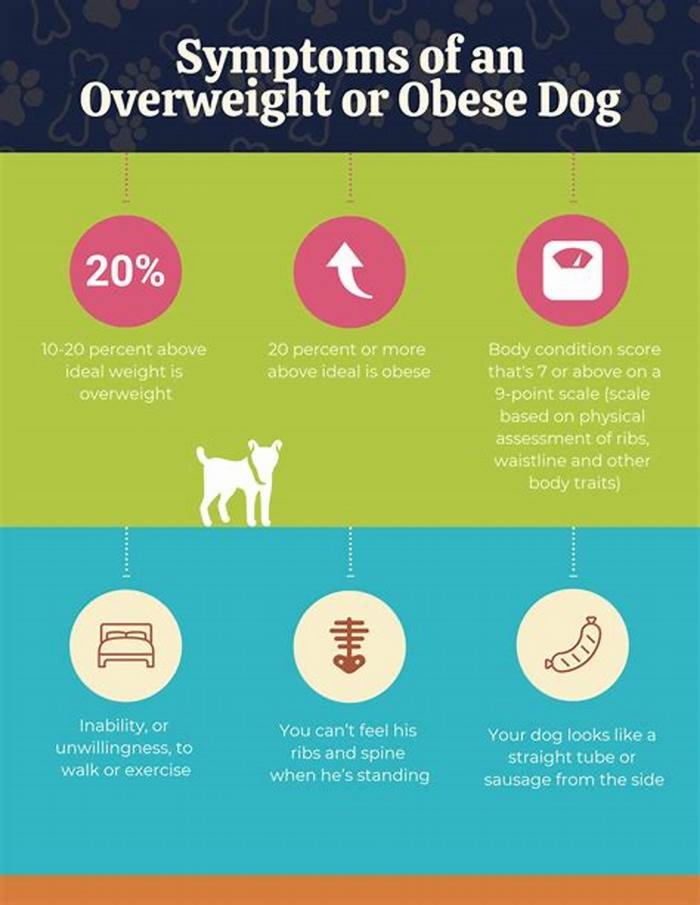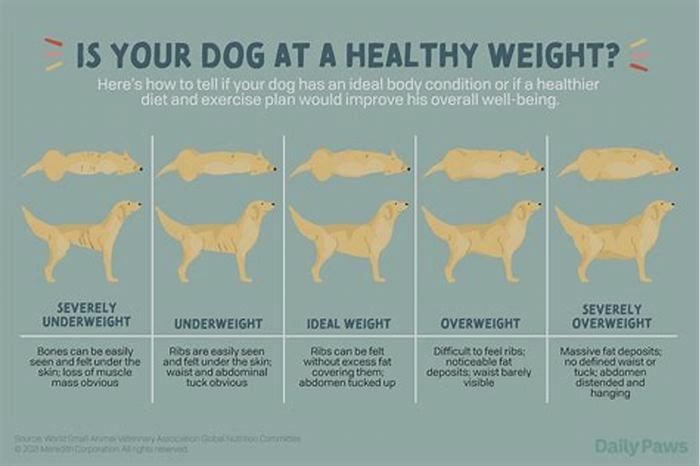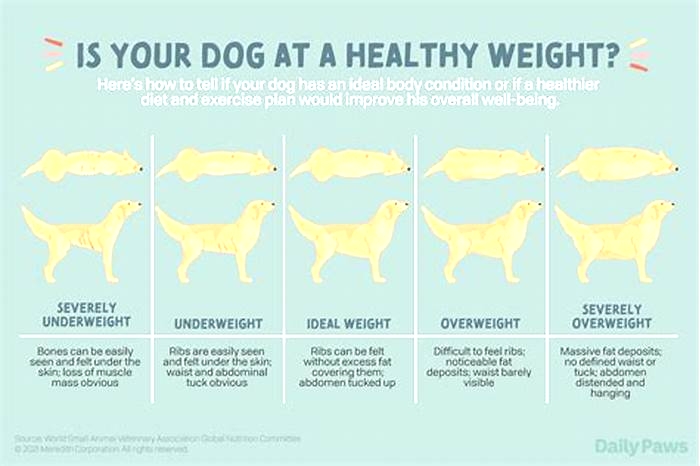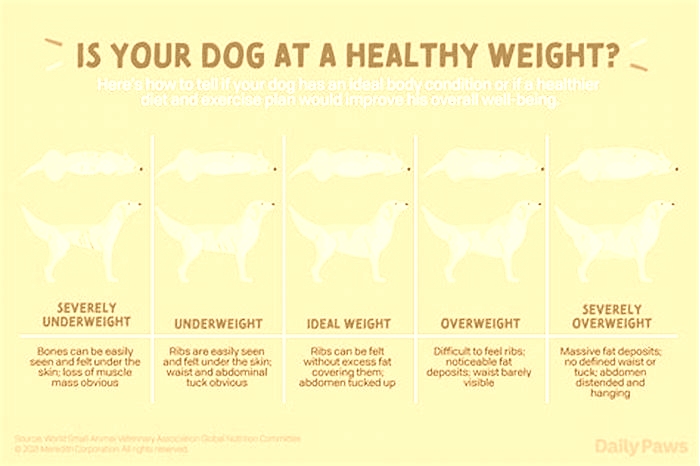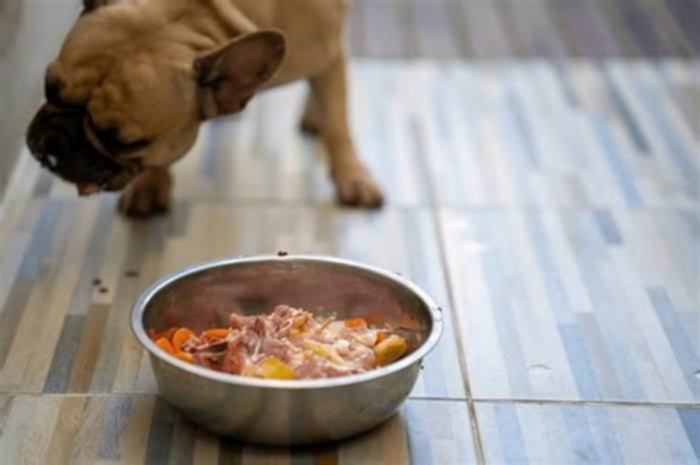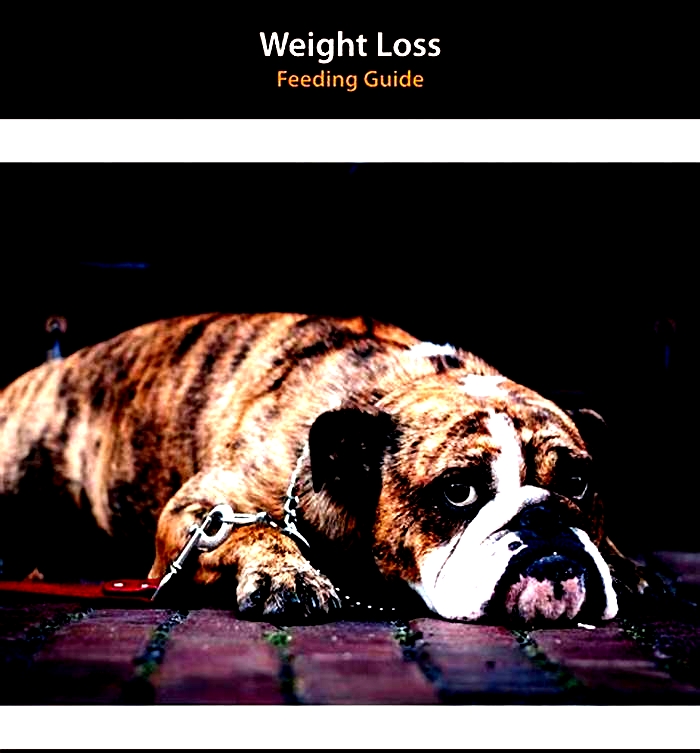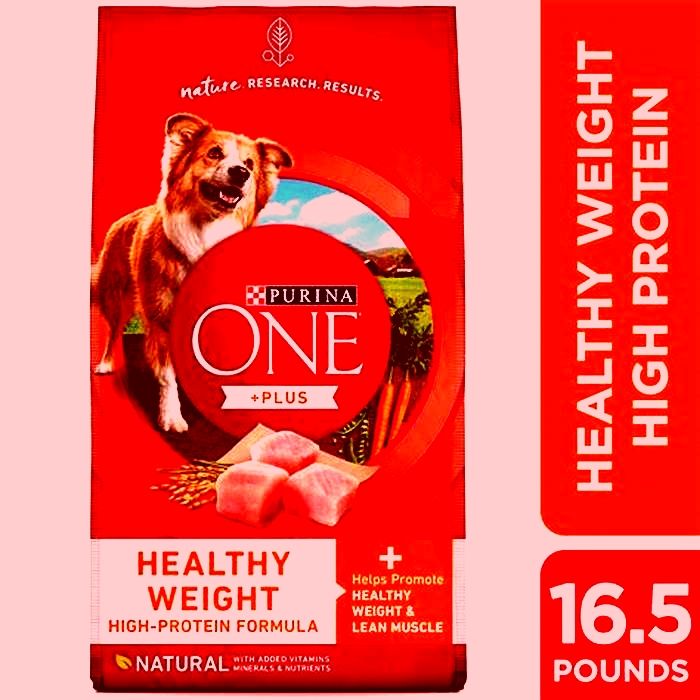The Role of Nutrition in Canine Weight Management Tips for Success
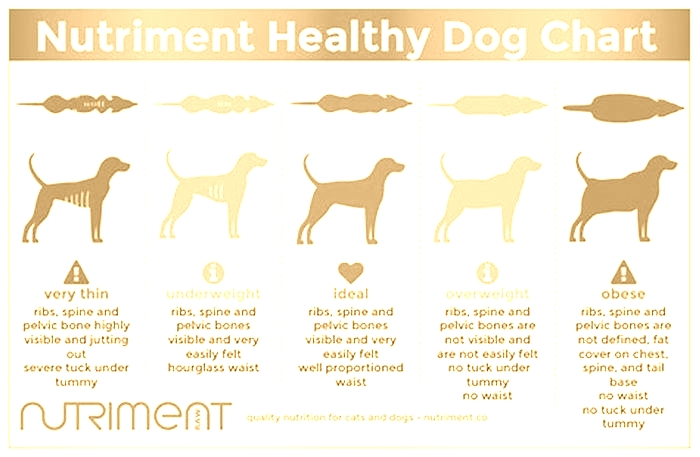
Elements of a Successful Weight Management Clinic
Checklists can help in obtaining all the information required from the pet owner during clinic visits (Box2). They can remind veterinary nurses of what questions to ask, ensure continuity between staff members, and be used as records in the clinical history.
BOX 2 Sample Checklist for Weight Loss Clinic Visits
WeightCurrent body weight:____________________________________
Ideal body weight:______________________________________
Body condition score:____________________________________
Diet InformationCurrent diet:__________________________________________Treats:______________________________________________Dental chews:_________________________________________Human foods:_________________________________________Number of meals per day:_________________________________
EnvironmentOther animals in household:_______________________________Access to other foods:____________________________________Exercise and play level:___________________________________
Other InformationCurrent health status:____________________________________Current medication(s):___________________________________Suitable food weighing scales at home?________________________Any hindrances to completing the program?_____________________Any questions regarding the program?_________________________
RecommendationsDiet and feeding plan:_____________________________________Exercise and play:________________________________________Actions Weight loss graph? Yes/NoNeck, chest, hips, tail base measurements? Yes/NoPhotos taken? Yes/NoFood diary:____________________________________________Next appointment:_______________________________________
Owner Behavior and Pet Obesity
Theoretically, weight loss can be achieved when the amount of calories consumed is less than an animals overall energy expenditure. Achieving the necessary reduction in calories and increase in energy expenditure in pets can be difficult, owing to owner education, owner compliance, lifestyle, and behavioral traits. The complex relationship between owner and pet therefore needs to be discussed as part of the weight loss program. Often, when obesity is addressed, the behavioral traits in the owner-pet relationship are compared with those between a parent and child,1 as pet owners have roles similar to parents (caregivers) in supplying food and using it as a reward.
Obesity treatment programs for humans that include behavioral interventions in conjunction with dietary changes and increased physical activity achieve higher success rates than those that do not include behavioral modifications.2 Pediatric obesity treatment programs that involve the whole family in intense behavioral interventions are more successful than those that do not, with the success of the programs related to the intensity of the behavior treatment.1 Such findings have implications for weight reduction in companion animals, with a positive correlation identified between the success of obesity treatment in dogs and behavioral changes of the owner.3 A standard obesity treatment program that included appropriate energy intake, monthly weight checks, and a structured maintenance period was sufficient to achieve these objectives.4
Owners of overweight cats indicate that they have a closer relationship with their cats than do owners of normal-weight cats, possibly with the cats serving as a substitute for human companionship.5 The over-humanization of the cats in these relationships may be related to weight gain.
The role of patient behaviorboth dogs and catsin weight loss also needs to be discussed during the veterinary nurse consultation; therefore, understanding feline and canine behavior (especially feeding behaviors) is also important.
The extent of behavioral advice and its role in treating obesity (especially in cats and multicat households) is vast. Consultation of resources such as those listed in Box 1 is highly recommended.
Feeding Quantities
Success in obesity clinics also relies on gaining a full understanding of how much food the owner is providing the pet. A 4 kg (8.8 lb) cat consuming just 10 kcal/day (the equivalent of approximately 10 kibbles or 10 g of tuna) in excess of its daily energy requirements will gain 12% of its body weight in one year.6 Accurate measurement of quantities fed is therefore required. As feeding scoops have proved to be very inaccurate,7 weighing out the daily portions should be the only method recommended for determining the amount being fed.
Diet history forms can be used to gain insight into an animals current energy intake and to record the initial nutritional history at the first clinic visit. A sample form created by the World Small Animal Veterinary Association can be seen below and downloaded here. However, obtaining a full nutritional history might need to be completed over a couple of visits, as the owner might not know how much they feed or even what brands.

Owners should be encouraged to keep a food diary for their pet. A study of weight loss in humansshowed that people who kept a record of what they ate were more successful.8 However, a surprising aspect of this study was the reluctance of people to participate in recording what they had consumed, perhaps because they were worried about being judged for it. For owners who are willing to undertake a food diary for their pet, long-term use of the diary may become a motivator to stay with the program.
Graphs that show weight loss can also be a motivating visual prompt (Figure 1). Graphs can be based on biometric measurements, such as weight, or morphometric (body shape) measurements, such as the diameter of the chest, neck, waist, and tail base. It is common for animals to not lose weight according to the scale but to lose centimeters around the waist. Seeing a record of these measurements can act as a real incentive for the owner to continue the weight loss plan.

Exercise and Obesity
If weight loss can be achieved by expending more calories than consumed, increasing calorie expenditure through increased exercise can aid in weight loss. More importantly, exercise helps to preserve lean tissue during a weight loss program and to maintain metabolism at a higher level.
Along with a food diary, owners can be encouraged to keep an exercise diary. For dogs, exercise can be monitored accurately with movement devices, GPS collar monitors, and apps that map walks with the owner. In the authors experience, some dog owners have difficulty judging walking distances, and most overestimate the exercise their dog gets. As part of increasing exercise, however, owners need guidance on the difference between quantity and quality. A 1-hour walk with the dog plodding along beside the owner burns fewer calories than a half-hour walk during which the dog is engaged in intense physical activity.
Cat owners can benefit from a discussion of natural play activity in cats. Anecdotally, many owners expect cats to play for periods longer than a natural feline pattern. Cats prefer to play for a few minutes several times each day than to play for one half-hour session. Play activity in cats needs to replicate hunting behavior, which involves many short, high-intensity bursts.9 These types of activity can be replicated through the use of toys that move on their own or have elements that move (e.g., feathers), toys that are meant to be moved by the owner, and toys that swing. The size of the toy needs to be appropriate to the size of the cat.
Environmental enrichment for cats (especially indoor cats) is very important. Cats explore their environment in 3 dimensions, and their home environment should take this into account. Cats should have the ability to climb and sit up high on safe platforms if they wish.
Diet
Once food and exercise amounts have been recorded, a feeding plan and an exercise plan can be created. In some cases, decreasing the pets daily energy intake to the correct level and instituting an appropriate exercise plan can be enough for the animal to attain and maintain a healthy weight. However, some pets require weight loss diets. The Pet Nutrition Alliance website (petnutritionalliance.org) is a good resource for details on how to create nutrition plans and it even provides species-specific calorie calculators.
The specific diet recommended needs to be the one most appropriate for the animalits life stage, age, and any specific nutrient requirements (e.g., for animals with chronic health conditions)and the owner. Owner considerations may include financial constraints, personal mobility, and ethical requirements, such as the desire to feed organic or natural diets. Veterinary nurses need to listen to these needs with regard to what the owner can realistically achieve for their pet. For example, if the owner has reduced mobility, they may not be able to exercise an obese dog to attain its ideal target body weight, but some weight loss will still be beneficial for the dog.
Treats should not constitute more than 5% of the pets overall daily energy intake, and all family members need guidance on this restriction. If an owner is unwilling to stop giving treats, these extra calories need to be calculated and added to the daily intake. Recommendations could include using lower-calorie treats or using the weight loss diet as treats. Owners should be reminded that a reward does not have to be food. Play, social interaction, grooming, exercise, and toys can all be used as rewards.
All topics discussed should be written down for the owner so that they have the details to take home with them. A copy of the completed checklist in Box 2 may be useful in this regard, as well as placed in the patients medical record.
Prevention
As with most things, prevention of obesity is better than treatment, but once a pet becomes a candidate for a weight loss clinic, only management is an option. Veterinary nurses should start the conversation about appropriate weight early and continue it often with pet owners. Teaching new puppy and kitten owners about monitoring body condition score (BCS) rather than ideal breed weights is recommended and can be facilitated through a hands-on approach. Every time an animal visits the practice, it should be weighed and have its BCS and muscle condition score (MCS) assessed and recorded on the clinical history. Weight changes should be highlighted to the owner and addressed. Long-term weight charts can also be used to visually show any increase (or decrease) in weight. During a weight loss program, MCS should be monitored to ensure that muscle mass is not also lost.
Discussions about obesity prevention at key times has been shown to decrease obesity prevalence later in life. Veterinary nurseled post-neutering clinics that showed owners how to judge BCS, discussed obesity prevalence, and gave dietary recommendations halved pet obesity rates later in life in one study.10 Neutering has been highlighted as a major risk factor in development of obesity, so reiteration of key messages about preventing obesity when a pet is neutered is a vital role for veterinary nurses.
Follow-Up and Monitoring
With all nutritional consultations and veterinary nurseled clinics, it is important to monitor and follow up on the progress of clients. Making clear recommendations to clients is key to success. The CRAFT model (Box 3), developed in 2009, shows that for compliance to be successful, the follow through aspect of the equation is required.11 Following through can take all different forms of communication with an owner, such as a phone conversation, email, text, or repeat consultation. Discussing with the owner at the initial consultation which form of communication works best for them can really aid in following through.
BOX 3 The CRAFT Compliance Equation<sup>11</sup>
C = R + A + FT
Compliance = Recommendation + Acceptance + Follow Through
Achieving compliance requires a good, clear recommendation, as well as client acceptance of that recommendation. However, even with client acceptance, compliance is often poor because the follow-through component is lacking. Reasons for failure of clients to follow through include forgetfulness, financial and time constraints, and unclear recommendations. Follow-through by the clinic is therefore essential.
Dog Nutrition Tips
A balanced diet is critically important to your dogs cell maintenance and growth and overall health. Barring any special needs, illness-related deficiencies, or instructions from your vet, your pet should be able to get all the nutrients he or she needs from high-quality commercial pet foods, which are specially formulated with these standards in mind.
But dogs of different ages have different nutritional requirements. So, how muchor how littleshould you be feeding your four-legged friend? Read on to learn what your pets body needs at the various stages of life.
Nutrients Your Dog Needs
Nutrients are substances obtained from food and used by an animal as a source of energy and as part of the metabolic machinery necessary for maintenance and growth. There are the six essential classes of nutrients dogs need for optimum healthy living.
WaterEssential to life, water accounts for between 60 to 70% of an adult pets body weight. While food may help meet some of your pet's water needs (dry food has up to 10% moisture, while canned food has up to 78% moisture), pets must have fresh clean water available to them at all times. A deficiency of water may have serious repercussions for pets. A 10% decrease in body water can cause serious illness, while a 15% loss can result in death.
ProteinsProteins are the basic building blocks for cells, tissues, organs, enzymes, hormones and antibodies, and are essential for growth, maintenance, reproduction and repair. Proteins can be obtained from a number of sources including animal-based meats such as chicken, lamb, turkey, beef, fish and eggs (which have complete amino acid profiles) and in vegetables, cereals and soy (but these are considered incomplete proteins).
Please note: Do not give your pet raw eggs. Raw egg white contains avidin, an anti-vitamin that interferes with the metabolism of fats, glucose, amino acids and energy.
Fats Fats are the most concentrated form of food energy, providing your pet with more than twice the energy of proteins or carbohydrates. Fats are essential in the structure of cells, needed for the production of some hormones, and are required for absorption and utilization of certain vitamins. Fats also provide insulation and protection for internal organs. A deficiency of essential fatty acids (such as linoleic acid) may result in reduced growth or increased skin problems.
Carbohydrates Carbohydrates provide energy, play a vital role in the health of the intestine, and are important for reproduction. While there is no minimum carbohydrate requirement, there is a minimum glucose requirement necessary to supply energy to critical organs such as the brain.
Fibers are kinds of carbohydrates that alter the bacterial population in the small intestine, which can help manage chronic diarrhea in dogs. For dogs to obtain the most benefit from fiber, the fiber source must be moderately fermentable. Moderately fermentable fibersincluding beet pulp, which is commonly used in dog foodsare best to promote a healthy gut while avoiding the undesirable side effects of highly fermentable fibers, like flatulence and excess mucus.Other examples of moderately fermentable fibers include brans (corn, rice and wheat) and wheat middlings. Foods that are high in fiber are not good for dogs with high energy requirements, and who are young and growing.
VitaminsTiny amounts of vitamins are necessary in dogs for normal metabolic functioning. Most vitamins cannot be synthesized in the body, and therefore are essential to obtain in the diet.
Please note that when feeding your dog a complete and balanced diet, it is unnecessary to give a vitamin supplement unless a specific vitamin deficiency is diagnosed by a veterinarian. Due to over supplementation, poisoning due to excess vitamins (hypervitaminosis) is more common these days than vitamin deficiency (hypovitaminosis). Excess vitamin A may result in bone and joint pain, brittle bones and dry skin. Excess vitamin D may result in very dense bones, soft tissue calcification and kidney failure.
MineralsMinerals are nutrients that cannot be synthesized by animals and must be provided in the diet. In general, minerals are most important as structural constituents of bones and teeth, for maintaining fluid balance and for their involvement in many metabolic reactions.
Weaning and Feeding Your Puppy
If youre responsible caring for puppies in the first few months of their lives, youll need to be prepared to move them from a diet of moms milk to regular puppy food. This process of gradually reducing a puppys dependency on his mothers milk, known as weaning, should generally begin between three and four weeks of age and is ideally completely by the time the puppy is seven to eight weeks.
When to Wean a Litter of PuppiesPuppies receive complete nutrition from their mothers milk for the first four weeks of life, so there is no need to feed them anything during that time. However, in the event that the mother dog is ill or doesnt produce enough milk during these four weeksor if the pups are found as orphansit may be necessary to feed them commercial milk replacer. If you find yourself in this situation, contact your veterinarian for product and feeding recommendations.
After that time, its best to let weaning be a gradual process that occurs over several weeks. This allows the mother dog to slowly dry up her milk supply and puppies need time to learn important behaviors from their mother and littermates, including how to interpret signs of dominance, inhibit their own biting habits and submit to more dominant dogs. Puppies generally begin eating puppy food around three to four weeks of age.
How to Wean a Litter of PuppiesStart by separating the mother from her litter for a few hours at a time. This time apart will reduce the pups dependency on their mothers milk and overall presence. While separated, introduce the puppies to eating from a pan. The amount of food, the frequency and length of separation can gradually be increased. As the puppies become independent and self-confident, they can spend more and more time away from their mother until they are completely weaned.
Take your time. It can be frustrating if puppies dont immediately take to the transition, but be patientperiodic setbacks are normal!
Caring for the Mother During the Weaning ProcessTo prevent the mother from overproducing milkwhich can lead to painful, engorged mammary glandsit is important to follow a feeding and separation schedule both for her and the puppies. This should be discussed with your veterinarian to ensure that the puppies are receiving adequate nutrition, and that the mothers food intake is being adjusted properly when she is no longer nursing her litter.
Feeding Your Puppy During the Weaning ProcessWhile weaning, its a good idea to feed puppies the same high-quality puppy food theyll eat throughout their entire growth period. Be sure to moisten the food with warm water (or puppy milk replacer) to create a soupy mix thats appealing to their sensitive palates.Puppies often play with their food when it is first introduced, but they will quickly learn what to do with it! Start with small quantities, and gradually increase the amount of puppy food. By the time the pups are completely weaned at seven to eight weeks old, they should be eating their dry food consistently.
How Much Dry Food to Feed Your PuppyPuppies require up to twice the energy intake of adult dogs and, depending on the breed, will need to be fed a food that contains 25 to 30% protein. Remember, the adult size of a dog is determined geneticallynot by how fast the animal grows. Do not overfeed in an attempt to accelerate a puppys growth rate.
If they are allowed to overeat, puppies can consume too many calories, grow too rapidly and develop health problems. Small breeds often reach their adult body weight in nine to twelve months. As puppies, its okay to leave dry food out for small them to peck as they wish. But most medium-breed puppies and all large- or giant-breed pups can suffer from bone or joint problems if they eat too much during this stage and benefit most from controlled feeding.
Feeding Your Adult Dog
Adult dogs require sufficient nutrients to meet energy needs and to maintain and repair body tissues. The amount you feed your adult dog should be based on his or her size and energy output. Activity levels may vary dramatically between pets, and will play an important role in determining caloric intake.
How Much to Feed Your DogThe amount you feed your adult dog should be based on his or her size and energy output. For example, an animal with a normal activity level should receive what we call maintenance energy. A pampered lap dog may require just 10% of that, while an active pet who exercises regularly outdoors may require maintenance plus 20 to 40%.
You may need to adjust portions as you learn your dogs ideal maintenance amount. Pet owners should always consult with their dogs veterinarian to determine the best feeding schedule and types of foods for their pets.
Outside factors, like the temperature, can contribute to how much your dog should eat. Since keeping warm and cool require extra energy expenditure, extreme hot or cold weather can also increase a dogs energy needs. Talk to your pets veterinarian about what to do when the mercury dips or soars.
Feeding Working Canines A dogs energy needs will increase with his or her work and stress level, and the dietary needs of working caninessuch as police dogs, guide dogs and cattle dogswill depend on their occupations. A dog with a moderate work load may require an energy increase of 40% compared to maintenance, whereas a dog with a high work load may require an extra 50 to 70%.
Feeding Your Dog as He Recovers from SurgeryAn animal recovering from surgery or suffering from a disease may have an increased nutritional requirement for repair, healing and fighting infection. Be sure to check with your veterinarian on your pets post-opt nutritional needs.Limiting TreatsTreats should be given in moderation and represent five percent or less of the dogs daily food intake. The rest should come from a nutritionally compete dog food. When using treats as motivation, such as during training exercises, use the smallest pieces you can.
Setting a Feeding Schedule We recommend all dogs be fed twice daily. Simply divide the amount of food your pet requires into two meals, spaced eight to twelve hours apart. Dogs may be fed in a number of ways that meet both the owners and the animals needs. These methods include portion-control, free-choice and timed feeding.
- Portion-control feeding refers to controlling the amount of food that your pet consumes by measuring your pets food and providing it in one or meals daily. This method is often used for weight control programs and for animals that might overeat if fed free-choice.
- Free-choice feeding allows food to be available to your pet at all times, as much as your pet wants, and whenever he or she wants it. This method is best when feeding dry food, which will not spoil when left out. Most nursing mothers are often free-choice fed, but some dogs will overeat when fed in this manner, resulting in obesity.
- Timed feeding involves making a portion of food available for your pet to eat for a specific period of time. For example, food can be placed in the dogs bowl for 30 minutes. After that time, if the pet has not consumed the food, it is removed.
Feeding Your Senior Dog
Dogs begin to show visible age-related changes at about seven to 12 years of age. There are metabolic, immunologic and body composition changes, too. Some of these may be unavoidable while others can be managed with diet. When feeding your older dog, the main objective should be to maintain health and optimum body weight, slow development of chronic disease and minimize diseases that may already be present.
Your Pets Size Will Determine When to Begin a Senior DietAs your dog ages, health issues may arise including deterioration of skin and coat, loss of muscle mass, more frequent intestinal problems, arthritis, obesity, dental problems and decreased ability to fight off infection. Since smaller dogs live longer and don't experience these age-related changes as early as bigger dogs, size is used to determine when its time to feed your canine a senior diet.
A good guideline to follow is:
- Small breeds and dogs weighing less than 20 pounds7 years of age
- Medium breeds and dogs weighing 21 to 50 pounds7 years of age
- Large breeds and dogs weighing 51 to 90 pounds6 years of age
- Giant breeds and dogs weighing 91 pounds or more5 years of age
Avoid "Senior" Diets That Have Reduced Levels of ProteinStudies have shown that the protein requirement for older dogs does not decrease with age, and that protein levels do not contribute to the development or progression of renal (kidney) failure. It is important to feed older dogs diets that contain optimum levels of highly digestible protein to help maintain good muscle mass.
Older dogs have been shown to progressively put on body fat in spite of consuming fewer calories. This change in body composition is inevitable and may be aggravated by either reduced energy expenditure or a change in metabolic rate. Either way, it is important to feed a diet with a lower caloric density to avoid weight gain, but with a normal protein level to help maintain muscle mass.
Talk To Your Veterinarian About Increasing Your Senior Dogs GLA And FOS IntakeGamma-linolenic acid (GLA) is an omega-6 fatty acid that plays a role in the maintenance of healthy skin and coat. Although it is normally produced in a dog's liver, GLA levels may be diminished in older dogs.
Aging can affect a dogs intestinal bacteria, which can result in symptoms of gastrointestinal disease. Senior diets for dogs should contain FOS (fructooligosaccharides) to promote the growth of beneficial bacteria.
Look For Foods with High Levels of Vitamin E and Beta-CaroteneAntioxidants such as vitamin E and beta-carotene help eliminate free radical particles that can damage body tissues and cause signs of aging. Senior diets for dogs should contain higher levels of these antioxidant compounds. Antioxidants can also increase the effectiveness of the immune system in senior dogs.
Maintain ConsistencyRoutine care for geriatric pets should involve a consistent daily routine and periodic veterinary examinations to assess the presence or progress of chronic disease. Stressful situations and abrupt changes in daily routines should be avoided. If a drastic change must be made to an older pet's routine, try to minimize stress by introducing the change in a gradual manner.
Overweight Dogs
One of the most common pitfalls dog parents should watch out for is overfeeding. Attempts to shower our dogs with love by means of big meals and lots of tasty treats are sweet, but misguided. In dogs, as with humans, extra weight can lead to health problems. Be sure to indulge your four-legged friend with affection, not food!
Causes of Obesity in DogsObesity is an extremely common problem in pets and, as with humans, it can be detrimental to the health of a dog. The overweight pet has many added stresses upon his body and is at an increased risk of diabetes, liver problems and joint pain.
Obesity develops when energy intake exceeds energy requirements. This excess energy is then stored as fat. The majority of cases of obesity are related to simple overfeeding coupled with lack of exercise. Certain groups of dogs appear to be more prone to obesity than others. Specific breeds, such as Labrador retrievers and pugs, and older dogs are particularly susceptible.
How to Tell if Your Pet is OverweightThere are a few ways easy ways to identify whether your pet has put on the pounds. You should be able to feel the backbone and touch the ribs in an animal of healthy weight. If you cannot feel your pets ribs without pressing, there is too much fat.
Also, you should see a noticeable waist between the back of the rib cage and the hips when looking at your pet from above. When viewed from the side, there should be a tuck in the tummy, meaning the abdomen should go up from the bottom of the rib cage to inside the thighs. Dogs who fail these simple tests may be overweight.
How to Help Manage Your Dogs WeightWe have a few tips that can help your pet shed the extra padding. Please note, if your pup has put on weight, we recommend that you consult your pets vet before starting on a weight loss program.
- Correct your pets diet. Overweight animals consume more calories than they require. Work with your veterinarian to select a more suitable food and determine your pets caloric requirements. The diet should contain a normal level of a moderately fermentable fiber and fat to prevent the skin and coat from suffering during weight loss.
- Increase regular exercise. Increasing physical activity can be valuable to both weight loss and weight maintenance. Regular exercise burns more calories, reduces appetite, changes body composition and will increase your pets resting metabolic rate.
- Modify your behavior. A successful weight management program means making changes in your behaviors that have contributed to your pets weight. For example, you may be giving your pet too many treats or not giving her enough opportunities to exercise.
- Here are some ways you can commit to your pets weight loss:
- Remove your pet from the room when the family eats
- Feed your pet several small meals throughout the day
- Reduce snacks and treats, and feed all meals and treats in your pets bowl only
- Provide non-food related attention with lots of affection

